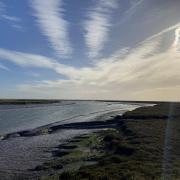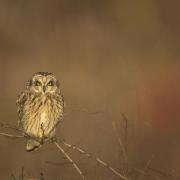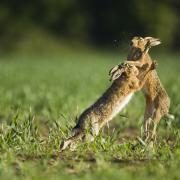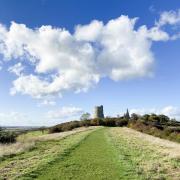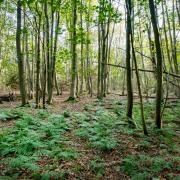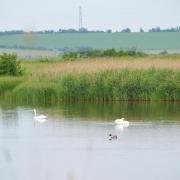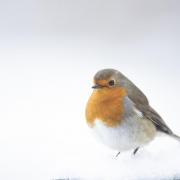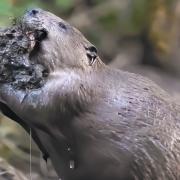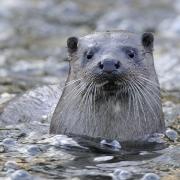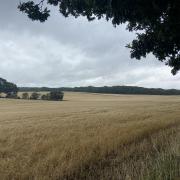Andrew Fallan shares his expertise in Essex wildlife with us. This week he talks about kingfishers in Rainham Marshes
Amid the rivers, streams and wetlands of Essex, you may be lucky enough to stumble upon a bird which, despite being among our most familiar, is usually only encountered as the briefest flash of the most brilliant azure-blue as it shoots upstream or downriver like a tiny missile, disappearing from view almost as soon as your eyes connect with it and your brain registers the sensory disruption.
In fact, so colourful is this bird that, were it not such an established part of our resident fauna, you could be forgiven for thinking that it simply does not belong in the British countryside, instead seeming more at home among the exotic inhabitants of some far-flung sultry rainforest or steamy mangrove swamp. I am talking, of course, about the wonderfully charismatic kingfisher, whose eye-popping, almost psychedelic beauty is sufficient to give any self-respecting peacock or bird of paradise a run for its money.
Kingfishers are fairly widespread throughout central and southern England, yet these surprisingly petite birds face a number of threats and are therefore incredibly vulnerable. Harsh winters can claim the lives of a significant proportion of the population, while flooding may prevent these birds catching fish – they rely on shallow, slow-moving water – and could even inundate their nest burrows, which are excavated in low, vertical riverbanks.
As well as being susceptible to both pollution and habitat degradation, kingfisher nests will also be targeted by predators such as rats and the American mink, with the latter being a particular source of concern as it is a non-native species that appears to be having a devastating impact on some of our wildlife, most notably water voles. It should, however, be remembered that it is not the mink themselves but us humans who are to blame, as these animals were brought to the UK for the fur trade, subsequently escaping from captivity or being freed by well-meaning if ecologically naïve individuals.
Despite their familiarity, kingfishers are elusive and not at all easy to see, with all but the most dedicated – or just plain lucky – among us being rewarded with the occasional fleeting glimpse. Nevertheless, I have chanced upon these remarkable birds on a number of occasions myself, including here in Essex. For example, along the River Chelmer, not far from Paper Mill Lock, I saw one flying low over the water in characteristic fashion like an oversized bluebottle. At the Essex Wildlife Trust reserve at Chigborough Lakes, as my wife and I sat on a bench looking out onto the gently lapping waters, a kingfisher suddenly shot past and then reappeared moments later, pausing to hover no more than about 20ft in front of us. I immediately raised my binoculars to my eyes, keen to savour this jaw-dropping spectacle, yet before I could even focus in on the bird, it was gone, leaving my wife as pleased as Punch and me kicking myself for trying to have my cake and eat it, but ending up with nothing but crumbs.
However, in my experience the best place to see kingfishers is the RSPB’s Rainham Marshes, which, a mere stone’s throw from the traffic and bustle of Lakeside Shopping Centre, provides a wonderful if rather unlikely wildlife haven. For the last few years, kingfishers have nested right in front of the reserve’s Marshland Discovery Zone, which also acts as a hide from which, with a bit of patience, you can feast your eyes on these resplendent birds as they fly to and from the nest, rest on a perch and even dive into the water for a quick bath – all a matter of feet away! From this vantage point, I have been blessed with the type of exquisite close-up views that are not only among my most cherished wildlife encounters, but are usually the privilege of professional film-makers or dedicated photographers who sit hunched over their camera for hours, even days, to capture the perfect shot.
So, if you fancy catching up with one of our most charismatic and colourful birds, not to mention a variety of other wildlife, I suggest you head down to Rainham Marshes.
However, assuming that they do breed there again this year, please remember that kingfishers are sensitive and easily disturbed, with any disruption to their parental duties potentially resulting in the eggs failing to hatch or the chicks not getting enough food. These birds are also protected under Schedule 1 of the Wildlife and Countryside Act, which makes it an offence to deliberately or recklessly disturb them at the nest site, so please keep any noise to a minimum, refrain from moving the makeshift camouflage netting and be prepared to observe any notices and instructions from staff.
Find out more
For more information on visiting Rainham Marshes, go to www.rspb.org.uk.






